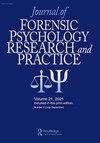Self-reported executive dysfunction among individuals deemed a ‘grave and immediate’ risk of harm to others: Are head injuries important?
IF 1.1
4区 心理学
Q4 CRIMINOLOGY & PENOLOGY
Journal of Forensic Psychology Research and Practice
Pub Date : 2022-03-10
DOI:10.1080/24732850.2022.2050333
引用次数: 0
Abstract
ABSTRACT The neuropsychological assessment of individuals with a mental disorder and deemed to be a ‘grave and immediate’ risk of harm to others admitted to one UK high-secure psychiatric care (HSPC) hospital makes an important contribution to the formulation of their difficulties and treatment needs. Included within the assessments is the DEX S questionnaire, assessing the subjective experience of any executive dysfunction (ED). An examination of 205 DEX S profiles suggests ED is common, particularly among younger individuals and with no difference between those who self-report a history of head injuries. Whilst a non-clinical non-forensic classification system suggested 43.9% of individuals fall into a ‘high deficit’ category and 24.4% fall into a ‘moderate deficit’ category, a HSPC classification system suggests higher thresholds, with 22.4% and 33.2% falling in ‘high deficit’ and ‘moderate deficit’ categories, respectively. Frequently endorsed items are associated with difficulties understanding others unless things are kept simple and straightforward, acting without thinking, expressing emotions, feeling restless, and problems sitting still for any length of time and being easily distracted. Results are discussed in terms of increasing awareness of ED among those involved in the care of mentally disordered offenders, cognitive remediation and the potential for a forensic psychiatric version of the DEX.在被认为对他人有“严重和直接”伤害风险的个人中,自我报告的执行功能障碍:头部受伤重要吗?
在英国一家高安全精神病护理(HSPC)医院,对精神障碍患者进行神经心理学评估,并认为他们有“严重和直接”的伤害他人的风险,这对他们的困难和治疗需求的制定做出了重要贡献。评估包括dexs问卷,评估任何执行功能障碍(ED)的主观体验。对205份DEX S档案的检查表明,ED很常见,特别是在年轻人中,并且在自我报告头部受伤史的人之间没有差异。非临床非法医分类系统显示43.9%的人属于“高缺陷”类别,24.4%的人属于“中度缺陷”类别,HSPC分类系统显示更高的阈值,分别有22.4%和33.2%的人属于“高缺陷”和“中度缺陷”类别。经常被认可的项目与理解他人的困难有关,除非事情保持简单和直接,不加思考地行动,表达情感,感到不安,以及长时间静坐和容易分心的问题。结果讨论了提高那些参与精神障碍罪犯护理的人对ED的认识,认知补救和DEX的法医精神病学版本的潜力。
本文章由计算机程序翻译,如有差异,请以英文原文为准。
求助全文
约1分钟内获得全文
求助全文
来源期刊
CiteScore
1.80
自引率
12.50%
发文量
53

 求助内容:
求助内容: 应助结果提醒方式:
应助结果提醒方式:


